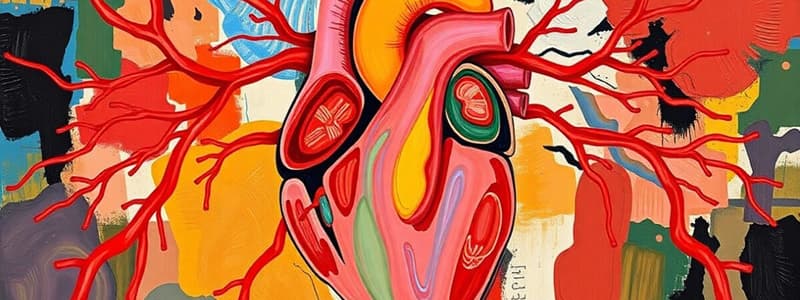Podcast
Questions and Answers
What is the primary function of the heart in the circulatory system?
What is the primary function of the heart in the circulatory system?
- To filter waste from the blood
- To pump blood through the blood vessels (correct)
- To produce red blood cells
- To transport oxygen through blood vessels
Which structures are primarily responsible for connecting veins and arteries in the circulatory system?
Which structures are primarily responsible for connecting veins and arteries in the circulatory system?
- Arteries
- Capillaries (correct)
- Ventricles
- Veins
Where is the pericardium located in relation to the heart?
Where is the pericardium located in relation to the heart?
- Within the inferior vena cava
- Inside the left ventricle
- Above the atria
- Surrounding the heart (correct)
Which chamber of the heart receives blood from the body and sends it to the right ventricle?
Which chamber of the heart receives blood from the body and sends it to the right ventricle?
What is the function of arteries in the circulatory system?
What is the function of arteries in the circulatory system?
What is the largest artery in the human body?
What is the largest artery in the human body?
Which type of blood cells are primarily responsible for carrying oxygen to the tissues?
Which type of blood cells are primarily responsible for carrying oxygen to the tissues?
What function does the septum serve in the heart?
What function does the septum serve in the heart?
Flashcards
Heart's Function
Heart's Function
The heart's main job is to pump blood throughout the body.
Capillaries: Connecting Veins and Arteries
Capillaries: Connecting Veins and Arteries
Capillaries are tiny blood vessels that connect veins and arteries, allowing for exchange of oxygen, nutrients, and waste products between blood and tissues.
Pericardium: Heart's Protective Cover
Pericardium: Heart's Protective Cover
The pericardium is a protective sac that surrounds the heart, helping to keep it in place and lubricate its movement.
Right Auricle: Receiving Blood
Right Auricle: Receiving Blood
Signup and view all the flashcards
Arteries: Carrying Blood Away
Arteries: Carrying Blood Away
Signup and view all the flashcards
Aorta: Largest Artery
Aorta: Largest Artery
Signup and view all the flashcards
Red Blood Cells: Oxygen Carriers
Red Blood Cells: Oxygen Carriers
Signup and view all the flashcards
Septum: Dividing the Heart
Septum: Dividing the Heart
Signup and view all the flashcards
Study Notes
The Circulatory System
- The circulatory system is made up of three main parts: the heart, blood vessels, and blood.
- The heart is a muscular organ that pumps blood throughout the body.
- The heart is located in the chest cavity between the lungs.
- It is about the size of a fist.
- The heart beats approximately 100,000 times per day.
- The heart pumps about 5-6 quarts of blood each minute.
- This equates to approximately 2,000 gallons of blood pumped each day.
- The pericardium is a protective sac surrounding the heart.
- Dr. William Harvey was the first to recognize the full circulation of blood in the human body.
- The heart has four chambers: two atria and two ventricles.
- The atria are the receiving chambers for blood entering the heart.
- The ventricles pump blood out of the heart.
- The septum is the wall that divides the right and left sides of the heart.
Blood Vessels
- Blood vessels are responsible for transporting blood around the body.
- There are three types of blood vessels: arteries, veins, and capillaries.
- Arteries carry blood away from the heart.
- Veins carry blood towards the heart.
- Capillaries are small, twig-like structures that connect arteries and veins.
- The superior vena cava carries blood from the upper extremities to the right atrium.
- The inferior vena cava carries blood from the lower extremities to the right atrium.
- The aorta is the largest artery in the body.
- Venules are the smallest veins in the body.
Blood
- Blood is a tissue made of red blood cells, white blood cells, platelets, and other substances suspended in plasma.
- Blood carries oxygen and nutrients to the tissues, and removes waste products.
Studying That Suits You
Use AI to generate personalized quizzes and flashcards to suit your learning preferences.




